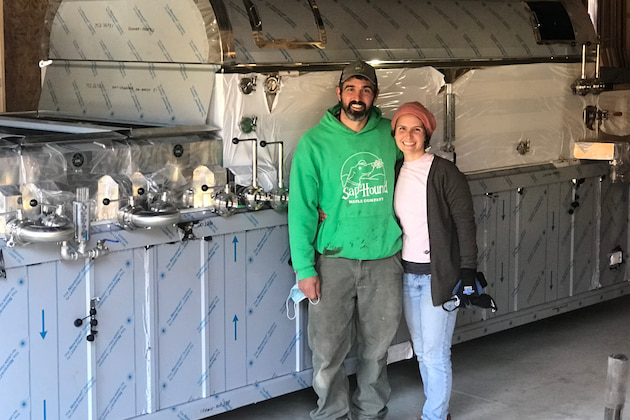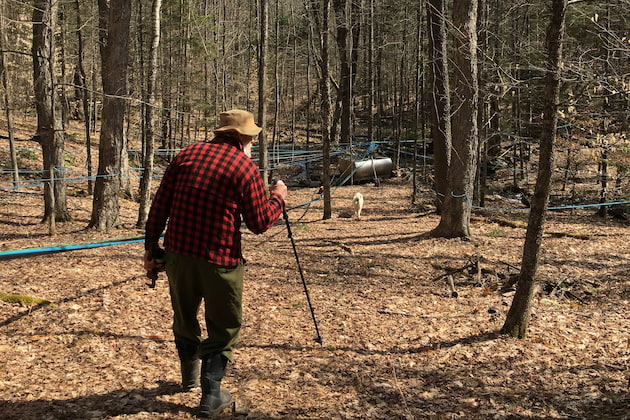Headlines
Sugarmakers endorse “Krueger Sanitation Method
Cleaning out 3/16ths lines after a season has benefits
By MICHAEL RECHLIN, FUTURE GENERATIONS UNIVERSITY | MAY 28, 2024
FRANKLIN, W.V.—Three-sixteenth tubing systems rely on gravity-initiated tension in the sap column to develop vacuum.
They provide substantial increases in sap flow without the added equipment and energy expenses of 5/16 vacuum systems.
What they do require is adequate drop to develop the pull. Over time it was discovered that 3/16 systems had their own problems.
Foremost of which is the accelerated growth of microbial mass, leading to clogging, at points of reduced diameter around fittings.
Also, with the tubes remaining filled with sap a greater volume of contaminated sap was being be drawn back into the tree during the freezing period of a sap flow cycle.
Various strategies are being developed to address these two drawbacks. The approach looked at here is a cleaning and sanitation technique we refer to as the “Krueger Sanitation method.”
Arthur Krueger, “The maple sage of the north” passed in 2022.
Arthur and his wife Trish ran, and Trish still runs, the Krueger-Norton Sugarhouse in Shrewsbury, Vt.
The Krueger-Norton operation has around 2,400 taps on a 3/16 collection system. Where others using 3/16 inch report a drop in production after the second or third year of use, Krueger claimed his production did not fall.
To verify that claim the Appalachian program of Future Generations University and the Food Science lab at West Virginia State University initiated a multi-year study on sanitation, sap flow, and the buildup of microbial mass in 3/16 sap lines.
Why clean and sanitize?
- Sanitation is recognized as important to producing high quality maple syrup.
- As the season progresses, and especially with warm spells during the season, a microbial mass, called biofilm, builds up on buckets, the interior of sap lines and in collection tanks.
- This buildup contributes to the darkening of the syrup as the season progresses, a shortening of the sap flow season through tap hole drying, as well as sour sap and ropey syrup.
The “Krueger Method”
Detailed in an “Out of the Woods” webinar presented by Future Generations University and available at https://www.youtube.com/watch?v=wEBnFFer2UA, the Krueger method is comprised of the following steps:
· Sanitize with 400ppm of food grade calcium hypochlorite
· Flush mainlines to avoid driving “gunk” into lateral lines
· Pump up lines from the base or siphon into lines from the top
· Sanitize while pulling taps in the spring, a must to remove residual sap in the lines from fermenting over the summer
· Leave sanitizing solution in the lines all summer
· Sanitize spouts, inside and out, by storing bathed in sanitizing solution in a stericap. No need to replace spouts every year
· Rinse with water or sap from the first sap run of the coming season
In the fall of 2023 and with the help of Albert and Nathan St Savior, from Sap Hound Maple, Brownfield, Maine, we were able to obtain sanitized 3/16 tubing and spouts.
Sap Hound Maple followed the Krueger method in their sanitation practices.
On some of their samples the spout had come out of the stericap and the solution drained.
The St. Savior’s question was, “are the lines that drained because the caps fell off still adequately sanitized.”
The answer, presented through the series of questions below, made us revisit key aspects of the “Krueger method.”
The first question is: Does sanitation, in fact, reduce microbial load? The answer is an unequivocal YES.
Sanitation greatly reduces microbial load but does not eliminate all microbes.
What apparently is happening is that as the active ingredient in the calcium hypochlorite is used up or breaks down it loses its efficacy.
Residual sugars from the sap and the water from the inactive sanitizing solution form a perfect media to recolonize the interior surfaces of the lines over the summer.

































